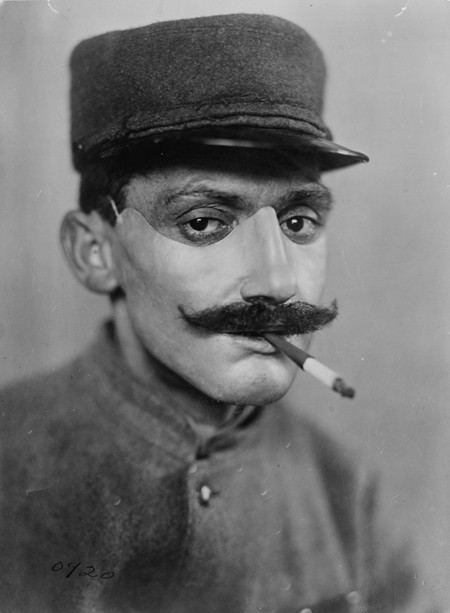These include traditionalists and modernists, innovators and reactionaries, patriots and anarchists. Among the figures considered are avant-garde modernists such as Man Ray, Marsden Hartley, and Marcel Duchamp; figurative artists such as George Bellows, Childe Hassam, and John Singer Sargent; photographers Edward Steichen, Alfred Stieglitz, Paul Strand, Lewis Hine, and James VanDerZee; and filmmakers D. W. Griffith and King Vidor. Such a wide array of creators allows for no one-size-fits-all conclusion; but a series of
To varying degrees, each chapter of the book mixes together fine art, commercial art, and material culture. One chapter that absorbed much of my attention during the fellowship year focuses on the relatively unknown makers of prosthetic masks for disfigured French and American soldiers. The Great War was the first major conflict to rely extensively on trench warfare. While trenches protected men’s bodies, they often left their heads exposed. A sniper’s bullet could shear off the jaw or tear away the nose of a soldier who raised his head at the wrong moment. Advances in battlefield medicine and ambulance services proved remarkable in saving the lives of those who in previous wars would have succumbed immediately, or within days. As never before, soldiers could have their faces pulverized beyond recognition but not die from the wounds—circumstances that compelled new developments in plastic surgery and facial prosthetics.
For those most severely wounded, full repair was rarely possible, and the faces of disfigured veterans haunted postwar society. Modern artists reacted to the war’s lingering brutality in aesthetically opposed directions. Some sought to expunge all ugliness and impurity from their art (the “return to order”), while others, primarily from the defeated nations, reveled in violent and misshapen forms. Either way, the conflict left its mark.
The public recoiled from the sight of patched-together or tin-masked faces. No one wanted to be reminded of the terrible mental suffering the war had exacted and, for the permanently disfigured, continued to exact. Nonetheless, improvements wrought through surgical and prosthetic intervention were impressive. They demonstrated that the human countenance is malleable and that badly damaged appearances can be changed for the better. Women
The United States as a whole experienced a moral letdown after the war. The semi-obliterated faces of wounded doughboys symbolized, at a profound and largely unarticulated level, the desecration of civic values. Close analysis of American visual culture in the decade or so following the armistice suggests that physical beauty became an all-consuming passion to a public haunted as much by ravaged bodies and as by eroded ideals.
Members' Research Report Archive
Grand Illusions
David M. Lubin, Wake Forest University
William C. Seitz Senior Fellow, 2013–2014
More than half a century ago, in his influential book American Painting from the Armory Show to the Depression (1955), the art historian Milton Brown (1911–1998) asserted: “The total effect of the [First World] war on American art was not great. It was more an interlude than anything else.” This view has never been seriously challenged, but I believe it should be. At CASVA I have pursued a project to do precisely that.
My book in progress, “Grand Illusions: America’s First World War and the Politics of Vision,” argues that World War I had a deep and lasting effect on the fine arts in the United States and on the nation’s broader visual culture. It seeks to accomplish this through interwoven art-historical studies of the World War I period and its aftermath: roughly from the Armory Show to the stock market crash or, in more political terms, from the sinking of the Lusitania to the rise of the Third Reich. My study assesses the effect of the war on approximately two dozen American painters, designers, photographers, and filmmakers from 1914 to 1933.

Unknown photographer, Soldier with Mutilated Face Protected by One of Anna Coleman Ladd’s Masks, 1918. Library of Congress, Prints and Photographs Division, American Red Cross Collection, Washington, DC